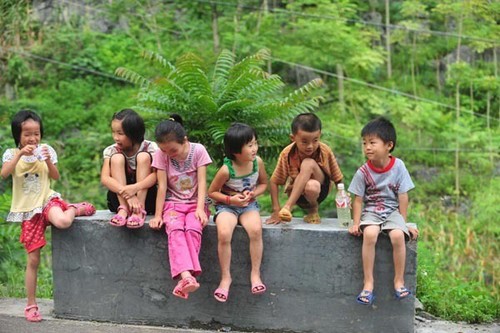
Qin Xiaohui (R) plays with the other children in his village on July 5, 2012. Qin Xiaohui, then 6, lives in Banlie Village of Bansheng Township in Dahua Yao Autonomous County, South China's Guangxi Zhuang autonomous region. (Photo/Xinhua)
The internet of things may hold great benefits for left-behind children, one of China's most vulnerable groups.
If you haven't caught up with the concept yet, the internet of things refers to physical objects - devices, vehicles, buildings and other items - embedded with electronics, software, sensors, and network connectivity that enables the collection and exchange of data. Objects can be sensed and controlled remotely, for example.
But what has that got to do with left-behind children in China?
To explore the answers, 24 students from six different countries, many from technical disciplines, gathered in Shenzhen in May, to design prototype devices with the goal of improving the education of the more than 60 million children whose parents have gone to work in cities without them.
"Before I came to the event, I remember reading news that kids committed suicide when their parents were far away. It upset me," said 18-year-old Kadallah Burrowes from the United States.
"I am glad that I got this opportunity, trying to do something to make a difference. It is not just something fun; it has the potential to help a lot of people. Small and cheap, with some government help, we might be able to turn the devices into something that helps the kids," said Burrowes, who majors in interactive media arts at New York University Shanghai.
Burrowes and his teammates designed a mango-shaped device that allows parents, wherever they are, to set various tasks for their children. The children then go to their grandparents or teachers for verification once a goal is achieved. Using the device, parents can stay involved in the growth of their children, the team said.
"Usually, the parents and children only meet once or twice a year. So the bond is weakening over the years," said Xin Haiyang, a PhD candidate in information engineering at The Chinese University of Hong Kong, Shenzhen.
To tackle the problem, Xin's team designed a "bonding tree", decorated with some lights, which are connected to the family members' phones. The lights turn from green to yellow and even red when the parents and children haven't talked for a certain amount of time.
The next symposium focused on children's issues in China will be held in December and more than 100 students, scholars and entrepreneurs are expected to attend, according to Eliot Gattegno, a director at The Chinese University of Hong Kong, Shenzhen.


















































